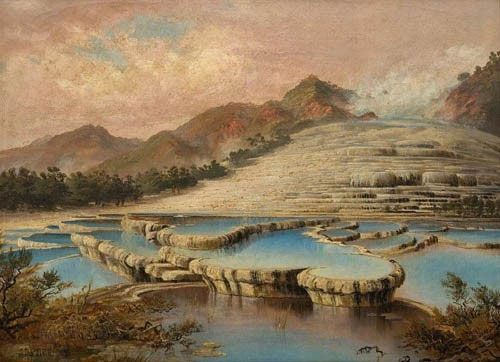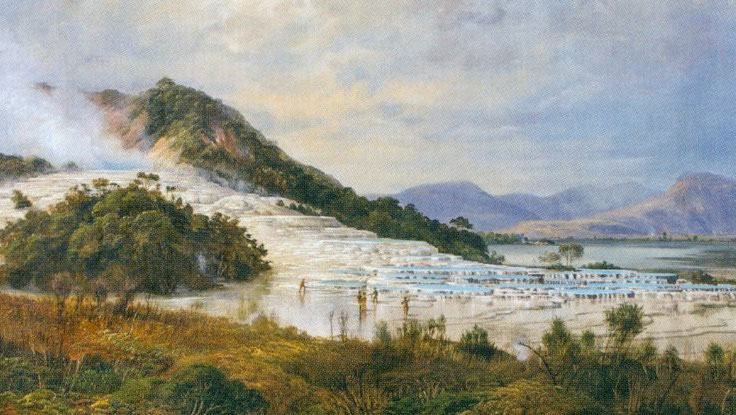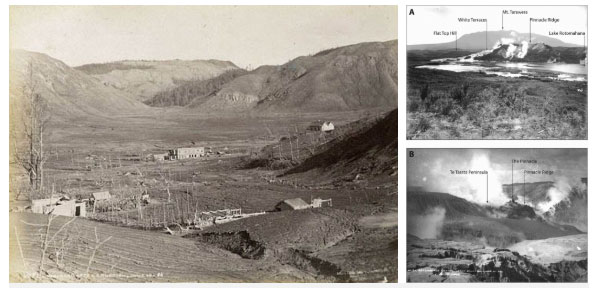'The 8th natural wonder' was wiped out by the volcano and hoped to recover after a hundred years of burial
Scientists are hoping to restore this lost wonder.
After more than 125 years of mystery, scientists believe they have confirmed the final resting place of a natural wonder - dubbed the 8th wonder of the world. Thereby, they also shed some light on the results obtained from previous research.
On June 10, 1886, Tarawera volcano suddenly woke up, Pink Terraces and White Terraces at Lake Rotomahana, New Zealand.

Charles Bloomfield painting of White ladder in 1893.
A little more, in two larger White Terraces, have another name, Maori as Te Tarata . They cover an area of 3 hectares and have a total of 50 steps before hitting the lake 40m below. Under the sun, the illuminated lake surface will show more white colors.
Pink Terraces , the locals call Otukapuarangi . This is the ladder that rises from a height of 30m over a distance of 75m.

The other step is the Red ladder.
Part of the water dissolves the minerals crystallized over hundreds of years and when the sun shines will show beautiful colors. Both beautiful terraces are provided with regular water thanks to two geysers located on Rotomahana Lake. However, the volcanic eruption in 1886 destroyed it all.
For hundreds of years, scientists thought that this eruption had completely destroyed, and disappeared from this wonder.

The image is amazing after the eruption of Tarawera volcano.
Cornel de Ronde, a research geologist at GNS Science in New Zealand, said: " The eruption caused a great destruction for New Zealand Island's northern steps."
While experts believe the White ladder has been completely destroyed, researchers have discovered that the Hong ladder is still hidden under the surface of Lake Rottomahana and is about 60m deep under the mud.
More recently, scientists have hypothesized: these terraces were buried on the shores of the lake in mild weather conditions and could restore the reputation of " unspeakable names" of previous landmarks.

We hope that we can witness this natural project in the future.
It is known that Dr. Sascha Nolden of the National Library of New Zealand found the diary of the Austrian geologist of Germany - Ferdinand von Hochstetter wrote a detailed description of the Pink and White ladder in 1859.
Although archaeologists are not sure if they have discovered this relic more than a hundred years ago, we hope that we can see this natural building in the future.
The study was published in the New Zealand Royal Society Journal.
- The smallest volcano in the world is just over 1m high, smoldering nearly hundred years
- Boxes buried 2,000 years old
- The goal is that few people know of burial on trees
- Strangely, burial of dead people lasted for years
- 'Eco-friendly' burial is becoming a trend!
- The dead are about to be buried as 'natural decay' in Washington
- The secret tomb of Genghis Khan is about to reveal
- Unusual burial practices in Tibet
- Japanese volcanoes wake up after years of sleep
- Volcanoes can 'wake up' in 2012
- The secrets of mummies
- This may be a new method of burial in the future
 'Fine laughs' - Scary and painful torture in ancient times
'Fine laughs' - Scary and painful torture in ancient times The sequence of numbers 142857 of the Egyptian pyramids is known as the strangest number in the world - Why?
The sequence of numbers 142857 of the Egyptian pyramids is known as the strangest number in the world - Why? History of the iron
History of the iron What is alum?
What is alum?